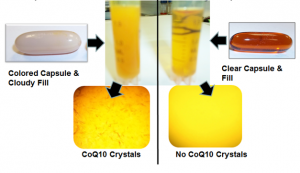
For absorption to be possible, the Q10 crystals must be completely dissolved into single molecules and must remain as single molecules at body temperature. Courtesy: Dr. William Judy, SIBR Research Institute.
Let’s start at the beginning. Both forms of Coenzyme Q10 – the ubiquinone form and the ubiquinol form — are active forms. At present, the ubiquinone form is, by far, the more documented form, especially in human studies.
Q10 as ubiquinone = the documented form
The ubiquinone form was used in the Q10 capsules that resulted in significant positive effects of Q10 supplementation in the Q-symbio study, in the KiSel-10 study, and in the Gulf War Illness study (3).
The absorption and bio-availability of the ubiquinone form is also well documented in humans (4).
Why the switch to Q10 in the ubiquinol form?
It has puzzled me that some major US producers of Q10 have switched from the ubiquinone form to the ubiquinol form despite the following discrepancies:
- the relative lack of documentation for ubiquinol
- the greater cost of the ubiquinol raw material and finished product
- the inherent instability of the ubiquinol molecule
Right from the beginning, in 2007, Kaneka Nutrients has pushed the ubiquinol product aggressively in the United States, so aggressively, in fact, that it initially made some hard-to-believe claims for 800 percent better absorption. It has since toned its claims down to 50% to 80% better absorption, but the details of the studies and the comparisons remain murky.
Much depends on which ubiquinone product the researchers use for comparison purposes. For example, comparing an oil-based ubiquinol product with a ubiquinone product in a virtually non-absorbable powder form is not a fair comparison.
No head-to-head comparisons
Furthermore, the absorption data that were used in the ubiquinone-ubiquinol comparisons came from studies that were not direct one-on-one scientific comparison studies. The data came, instead, from studies that were done in the following ways:
- done some ten years apart
- done by different scientists
- done with different protocols and different analytical methods
So I have been stumped. Is the ubiquinol form better for me? If so, then I want it. But I simply cannot see the evidence.
Getting Dr. William Judy’s take on Q10
Puzzled as I was, I turned once again for advice to Dr. William Judy, whose Ph.D. work was done in the fields of physiology and bio-physics. As a young man, Dr. Judy was trained by Japanese biology and medical professors, and Dr. Judy worked closely, for many years, with Dr. Karl Folkers, the grand old man of Q10 research. If anyone should be able to sort out the puzzle of the different forms of Coenzyme Q10, it should be Dr. Judy, I thought.
And Dr. Judy gave me an unequivocal answer. He said that the question of ubiquinone versus ubiquinol has haunted him since 2006-2007. For his own edification, he has collected and read the existing studies on the absorption and the bio-availability of the ubiquinol product.
No physical basis for a better absorption with ubiquinol
Dr. Judy cannot see any physical basis for a better absorption of Q10 in the form of ubiquinol. He points out that the ubiquinol molecule is slightly larger than the ubiquinone molecule. He sees no reason to think that the ubiquinol form could be made more than slightly more water soluble than the ubiquinone form. (The ubiquinone Q10 molecule is a fat-soluble molecule.)
Ubiquinol very unstable
Q10 in the ubiquinol form has been seen, in lab work, to be very unstable. The ubiquinol converts to the ubiquinone form whenever the ubiquinol is exposed to room air or is exposed to the acid in the stomach or is exposed to the chyme in the small intestine.
Ubiquinol converted to ubiquinone Q10 in the stomach
Dr. Judy’s data show that Q10 taken as ubiquinol is converted to the ubiquinone form in the stomach. The Q10 is then absorbed as ubiquinone. Then, the Q10 is converted to ubiquinol in the absorption cells and in the abdominal lymph and the thoracic lymph. Dr. Judy’s theory is that this conversion is probably due the presence of an oxy-reductase enzyme in the absorption cells, or in the lymph ducts.
The analysis of work done in Dr. Judy’s research institute, the SIBR Research Institute, shows that the ubiquinol product is not significantly better absorbed and is not significantly more bio-available than a good crystal-free lipid-based ubiquinone Q10 product is.
Q10 crystal-free and dissolved in oil
The key to absorption, according to Dr. Judy, is to develop a Q10 preparation, whether ubiquinone or ubiquinol, that is free of crystals because the body cannot absorb Q10 crystals that have not dissociated to single molecules in the fluids in the stomach and small intestine. Our absorption cells simply cannot absorb a crystal.
So where are we now?
Should I be buying a ubiquinol product? Will it give a better energy production or a better antioxidant protection? I admit it. I am confused.
I am being told to pay more money for a substance that is less stable than the ubiquinone Q10 that I am taking at present. I am being told to pay more money for a substance that will be converted to ubiquinone when it hits my stomach anyway.
And I know that the Q10 molecules convert back and forth many times in the cells, from the ubiquinone form (the oxidized form) to the ubiquinol form (the reduced form) and back again and again, contributing to cellular energy production when in the ubiquinone form and providing antioxidant protection when in the ubiquinol form.
Need for more scientific studies with humans
The thing is, I have available to me the results of well-designed placebo-controlled studies done with ubiquinone and published in peer-reviewed scholarly journals. For ubiquinol, I don’t find in Medline any studies that are nearly as impressive.
I really need for Kaneka Nutrients to fund and carry out some big randomized, double-blind, placebo-controlled studies in hundreds of patients diagnosed with heart failure and in hundreds of healthy elderly people just as was done in the Q-symbio study (1) and in the KiSel-10 study (2).
Sources:
- Mortensen SA, Rosenfeldt F, Kumar A, et al. The Effect of Coenzyme Q10 on Morbidity and Mortality in Chronic Heart Failure: Results From Q-SYMBIO: A Randomized Double-Blind Trial. JCHF. 2014;():. doi:10.1016/j.jchf.2014.06.008.
- Alehagen, U., Johansson, P., Björnstedt, M., Rosén, A., & Dahlström, U. (2013). Cardiovascular mortality and N-terminal-proBNP reduced after combined selenium and coenzyme Q10 supplementation: a 5-year prospective randomized double-blind placebo-controlled trial among elderly Swedish citizens. International Journal Of Cardiology, 167(5), 1860-1866. doi:10.1016/j.ijcard.2012.04.156
- Golomb, B. CoQ10 and gulf war illness. Neural Computation 2014 Nov; Vol. 26 (11), pp. 2594-651
- Singh, R. B.,Niaz, M. A., Sindberg, C. D.,Moesgaard, S.,& Littarru, G. P. (2005). Effect of oral coenzyme Q10 dosages on serum Q10 and MDA levels among healthy men. Paper presented at the International Coenzyme Q10AssociationMeeting Abstracts, Los Angeles, CA


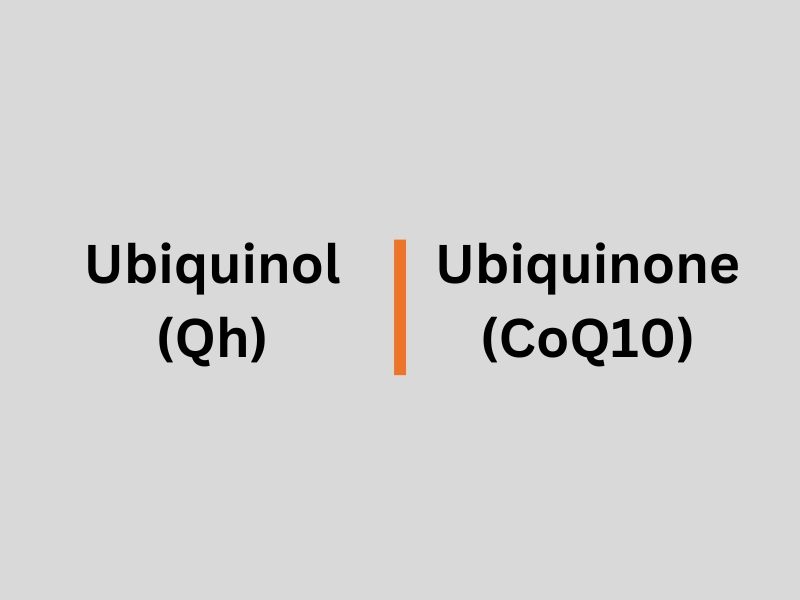
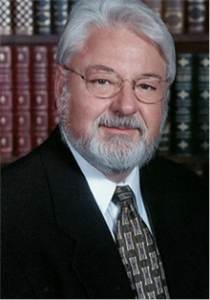
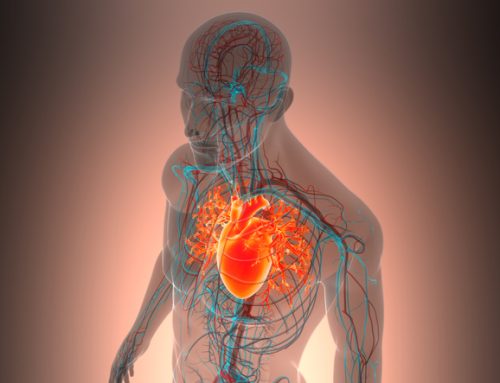



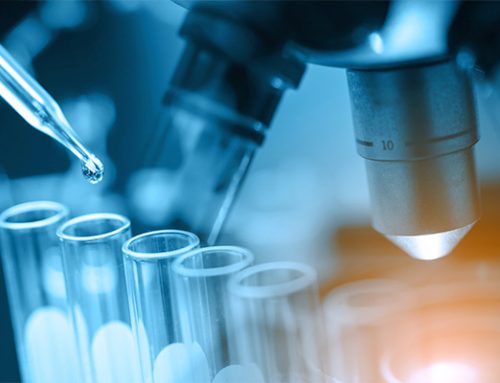
I have just started taking Pharma Nord Bio-Quinone active Q10 to help reduce systolic blood pressure So far so good it seems to be working. Thank you for your article as I was getting confused as to which I should take. I will now stick with ubiquinone. I have stopped taking my blood pressure tablets since starting with the above mentioned product. I take my pressure daily and have seen it drop from the 135/145 range to 110/129 range. If this continues no more blood pressure tablets for me or the side effects I was getting. regards Liz
Quote: I really need for Kaneka Nutrients to fund and carry out some … studies …
It would be better if Kaneka did NOT fund those studies imho.
I think that the key word in your comment is the word “claimed.”
Can you tell me where and when this claim was published and by whom it was made?
Is the study to which you refer an in vitro study, a culture dish study?
It is important that in vitro studies reproduce physiological conditions, i.e. gastric digestion juice that contains hydrochloric acid at a PH of 2.2 and a realistic mucus layer over the absorption cells in the culture dish to protect them against the acid.
I would like to know in which cells (and which type of cells) the claimed higher levels of concentration in the mitochondria were found and how the claimed higher levels were measured.
If you have a citation, please send it to me. Thank you.
[…] WeightWorlds Q10 indeholder ubiquinone, som er den mest dokumenterede form for Q10. […]
Hi –
I have to confess, I am most influenced by the clinical heart health benefits documented in the Q-Symbio study — improved symptoms and improved survival in heart failure patients — and in the KiSel-10 study – improved cardiac function and reduced cardiovascular disease mortality risk.
Both studies were done with a CoQ10 preparation produced in Denmark under pharmaceutical control
https://pubmed.ncbi.nlm.nih.gov/25282031/
https://pubmed.ncbi.nlm.nih.gov/22626835/
Please see http://www.q-symbio.com/can-i-get-the-same-q10-used-in-the-study
Best regards,
Richard